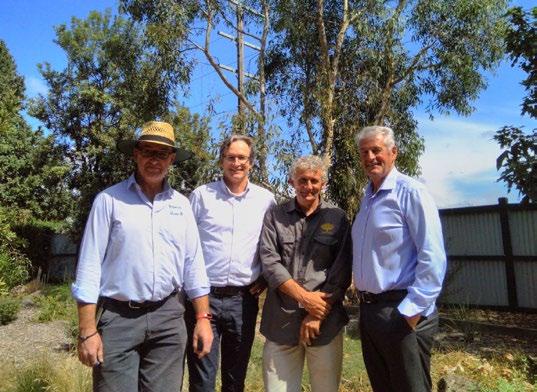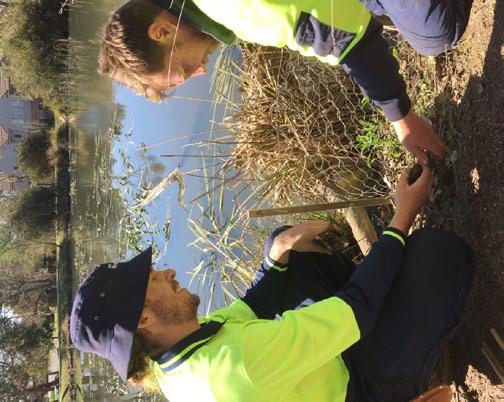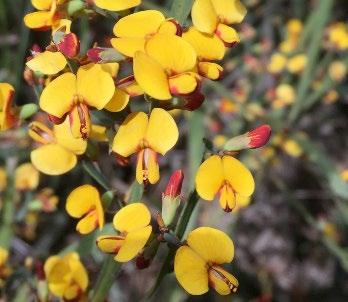
10 minute read
Regional botanical gardens can join the conservation conversation, too
The hort. section looks at the conservation journey Ballarat Botanical Gardens (BBG) has been on. Famed for its begonias, Donna Thomas tells us about how BBG is now embracing indigenous plants. And from Eleni Vassiliadis, we learn about some of the grand old trees at RBGV Melbourne Gardens and the efforts that arborists go to to protect their unique values.
Donna Thomas, Gardens Collections Officer, Ballarat Botanical Gardens
As a heritage-listed, primarily exotic, and regional botanic garden, Ballarat Botanical Gardens (BBG) did not have Australian plant conservation on the radar. We had believed those plant conservation projects required the expertise of large state botanic gardens with scientists and seedbanks, not regional botanic gardens like ours – or so we thought.
In just two years, plant conservation has become one of our gardens’ first conversations through better understanding of our existing collections and implementing simple, low cost and small-scale projects.
We now thrive in talking about Australian plant conservation with a new Ballarat indigenous plant collection, four indigenous species conservation projects, an endangered grasslands project, and the forthcoming BGANZ Care for the Rare project – all things we would not have thought possible a short time ago.

We’re learning so much along the way, from the support gained, new networks found and the immense and unexpected benefits for our team, our gardens, and even for a few plants! Care for the Rare site inspection – Peter Marquand, Chris Russell, John Arnott, Cr Jim Rinaldi
We were keen to be a part of the conservation conversation but as a mature garden with few replanting opportunities, we were uncertain how we could join in.
We started to prioritise threatened species where available, but it was a simple cross-reference against the IUCN Red List, that revealed 19 of our existing tree species were rare or threatened, and we already had an existing conservation collection and a global story to tell.
A background search of our registered tuberous begonia collection also unveiled a rare cultivar collection. Our gardens have a long-standing connection with Blackmore and Langdon nursery of the United Kingdom. For over 100 years we had imported begonias from them. Even today, half of our collection still originates from them. You can imagine our joint surprise when it was discovered that 75 of their cultivars, which they now consider rare or possibly lost from cultivation, are alive and well and hidden in our collection.
But it was our Wollemi Pine that started our Australian conservation story. Sharing its amazing story of discovery and rescue never fails to raise eyebrows, and what seems to resonate most, is that it is an Australian story.
Putting indigenous plants front and central
In 2017, the renovation of our Australian garden presented an exciting opportunity to refocus the garden and showcase the beauty of our local forest and grassland species.
All remaining lower and middle story plants were replaced with over 40 indigenous species, including six threatened species that occur naturally within a 50 kilometre radius of Ballarat. This change has been immensely popular with visitors, students and locals alike. It has also provided a relevant, secure location for our conservation projects, and it facilitates discussion about threatened local plants when we are undertaking tours of the garden.
Selecting the 50-kilometre radius also provides a focus for our conservation projects, and maintains consistency in our message.
Lepidium hyssopifolium, Basalt Peppercress
In 2017, the Victorian Department of Environment, Water, Land and Planning (DEWLP) approached us about planting a living seedbank for the endangered Lepidium hyssopifolium, which exists in Victoria as only seven populations. This short lived, herbaceous species has a dislike for weed competition and as a result several of the remaining wild populations live under Hesperocyparis macrocarpa, Monterey Cypress, often in high-risk areas on private land subject to grazing by livestock.
This first project was to simply plant tube stock provided by DEWLP, create an ex-situ population, and harvest the seed. In DEWLP’s own media release they described Lepidium
hyssopifolium as having ‘no floristic beauty: it looks like weed…’. Not a great first pitch we thought, but by the time they’d finished, our very simple project came out of their media department sounding like a really exciting new discovery! It was a really invaluable insight into the importance of getting the message out there and in how to generate positive momentum for conservation more broadly.
The Lepidium grew well and seeded prolifically, and within months we were sending seed to Royal Botanic Gardens Victoria’s (RBGV) seedbank. It was then forwarded to Royal Botanic Gardens, Kew’s Millennium Seed Bank Project, conserving the provenance for the future. Very simple, very exciting! We were sold, and commenced a second-stage planting at the botanical gardens wetlands to observe its preferred habitat and plant establishment methods.

Botanical Gardens Team receiving Lepidium hyssopifolium tube stock from DEWLP. Photo: Donna McMaster, DEWLP
Joining the Basalt Peppercress Working Group has also linked us with passionate, like-minded people right across the region, including other local councils, community groups, and individuals, all working together to protect or re-establish the species across the region more broadly.

Bossiaea vombata, Wombat Bossiaea
Buoyed by the simplicity of the Basalt Peppercress project, we didn’t hesitate when DEWLP suggested Stage two – Lepidium hyssopifolium project at Botanical Gardens wetlands
a second project with the endangered Bossiaea vombata. A rhizomatous, leafless species, with attractive yellow-red pea-type flowers, B. vombata is endemic to the Wombat State Forest where it exists in just four sites.
Without any mature fruit or seeds formally described, it was believed that the plant may not produce mature seed, and its rhizomatous nature created uncertainty as to how many genetically distinct plants there were. All populations are growing at high-risk sites adjacent to dirt roads, subject to road grading and in high fire-risk areas. Our project was to monitor the wild population, explore propagation methods and optimistically, try to secure an ex-situ population in the BBG.
Searching for information about this species led us to RBGV’s Neville Walsh and Elizabeth James, who have been an invaluable source of information about the species and have been able to answer our copious questions. The RBGV Nursery has also successfully grown several B.vombata plants, but advised that the species are notoriously unexcited about reaching their first birthday, and often go into decline soon afterwards.
The Australian National Botanic Garden (ANBG) was also working on conservation projects within the Bossiaea genus. They too generously shared propagating methods they have found successful with closely related species.
On field trips we found hundreds of flowers and, later, fruit, and a few immature-looking seeds. We were ecstatic. Seed sent to the RBGV seedbank, however, was confirmed as lacking maturity, but at least we had found out what a mature seed didn’t look like. On further field trips we collected cutting material and, the following year, more promising looking seed.
Bossiaea vombata findings so far
Bossiaea vombata does produce viable seed, as small as 1.5 mm. Four seeds have germinated, although the seedlings were short-lived. Samples of flowers, fruit and seed have been sent to RBGV. Elizabeth James has completed genetic and pollen studies to show five distinct plants, and pollen which is complete and viable.
Cuttings have struck from all four sites and we currently have four plants that have celebrated their first birthday – a milestone that was not lost on anyone.

Bossiaea vombata flowers
Senecio behrianus, Stiff Groundsel
Senecio behrianus is an endangered herbaceous rhizomatous wetland plant, which was believed to be extinct until in 1991. Four populations were discovered near Corop in northern Victoria), and a fifth was found in 2004 within a suburban Ballarat wetland. Due to its rhizomatous habit, each population is believed to consist of very few individual plants, possibly self-incompatible and possibly unable to produce viable seed in its natural environment.
In 2018 we approached DEWLP to see if this local population needed some assistance, as the species was located in a wetland already managed by our city. A national recovery plan already existed and provided a list of priorities for the species’ conservation. By contacting the other
botanic gardens mentioned in the plan, we were able to find current conservation projects and population sizes, and understand gaps we could contribute to. We’ve since propagated and planted an ex-situ population within our Australia Garden for safeguarding and display, collected seed, and have plans for trials within the varying water depths of the botanical gardens wetlands.
In this project, one of the great benefits has been working with other teams. Another City of Ballarat team, which maintains ‘trails and waterways’ including these wetlands, has enthusiastically joined the project, undertaking field monitoring and measurement of the population. The Ballarat Community Indigenous Nursery is working with alternative propagation methods. This has enabled more people to be involved and a broader benefit for the project than would be possible with the resources we have ourselves.
Conservation of endangered grasslands
Victoria Park is a 130-hectare inner city park located only 500 metres from our botanical gardens. Planted in 1890, it consists of sporting fields, copses of exotic trees, with approximately one third protected as remnant indigenous grasslands. With indigenous grasslands of the Victorian Volcanic Plains listed as critically endangered, we have a unique conservation zone in a central city location.
Undertaking a simple floral photographic survey to better understand the grassland species unexpectedly also unveiled the beautiful and endangered Dianella amoena in the park for the first time. Unlike our Lepidium, this was ‘a floristic beauty’ and it has become our poster plant for these grasslands. Many of these grassland species, including D. amoena have also been planted in the Australia Garden as ‘botanical signposts’ to facilitate conversation and encourage awareness in this endangered ecosystem just down the road.

A photographic survey unveiled the endangered Dianella amoena in Victoria Park
Care for the Rare collection – coming soon
We are fortunate to be included in the first round of BGANZ Victoria’s Care for the Rare program, which provides rare and threatened collections to regional botanical gardens.
This exciting program, supported by Royal Botanic Gardens Victoria and the Helen McPherson-Smith Trust will see our Australia garden almost double in size to accommodate an exciting new collection of threatened indigenous plants. We are looking forward to planting in autumn 2020.
Lessons learnt along the way
• It is invigorating to have new projects and new challenges that call on more creative thinking and problem solving.
• These projects have had huge unexpected benefits for our team. All members of our team, including nursery, garden and apprentices, are an important part of these projects, from wild collecting material, propagating, planting and maintaining plants, and any small success is a team achievement.
• DELWP have provided invaluable direction and connections to people who have knowledge of the various species. Whilst they have a long list of plant species that need a helping hand, ask them what species may need assistance in your area, within the resources you have available. There are many plants that ‘are’ the domain of scientists and seedbanks for a reason!
• Trials without success, have not been viewed as negatives, but instead as challenges, stimulating enquiring conversations about improvements, and alternative methods for next time.
• Find your hidden conservation collection or grow one!
• Take joy in the small achievements.
• Don’t be afraid to ask the simple questions – they often provide the most valuable answers.
• Other gardens have been very generous in sharing information. Find out who else is working on the species, or related species – lessons they’ve learnt will save you a lot of time and enable your resources to have a more meaningful contribution.
• Start small. We’ve chosen small projects that fit within our already fully loaded working schedule, and limited space – each project consists of only a dozen or so pots, not benches of plants.
• Get to know your existing collections – you may just have a conservation story already.
• Most importantly, don’t sell yourself short as a regional botanic garden, if we can, you too, can join the ‘conservation conversation’.










